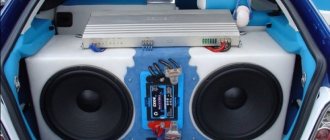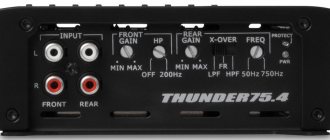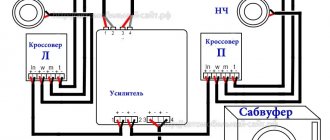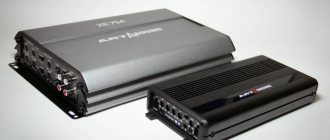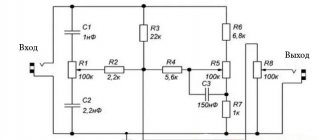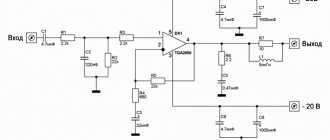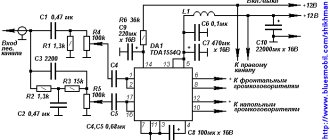At first glance, it may seem that the process of choosing an amplifier for speakers or a subwoofer in a car is not so simple. But with a brief instruction on “How to choose an amplifier” there will be no problems. The purpose of an audio amplifier is to take a low level signal and convert it into a high level signal to drive the speaker.
They may differ in the number of amplification channels, power and cost. Two and four-channel amplifiers are in greatest demand among car enthusiasts. Now let’s answer in more detail the question of how to choose an amplifier for a car.
Classes of car amplifiers
First of all, I would like to talk about the classes of amplifiers; at the moment there are a large number of them, but we will look at the two main ones, which are very often found in car audio systems. If you are interested in this topic in more detail, at the end of the article there is a video that talks about all the classes of car amplifiers that are now available.
- Class AB amplifier. These amplifiers have very good sound quality and, when connected correctly, are reliable and durable. If an AB class amplifier has a lot of power, then it has very large dimensions; these amplifiers have a low efficiency of about 50-60%, i.e., if 100 W are supplied to them. energy, then a current of 50-60 watts will reach the speakers. The rest of the energy simply turns into heat. AB class amplifiers should not be installed in a closed space, otherwise in the heat it may go into protection.
- Class D amplifier (digital amplifier). Class D is mainly found in monoblocks (single-channel amplifiers), but there are also four and two-channel ones for connecting acoustics. This amplifier has many advantages. Compared to the AB class, with the same power, it has very compact dimensions. The efficiency of these amplifiers can reach 90%, it practically does not heat up. D class can operate stably at low ohm loads. Everything would be fine, but the sound quality of these amplifiers is inferior to class AB.
In conclusion, we will draw a conclusion for this section. If you are chasing sound quality (SQ), then it would be better to use class AB amplifiers. If you want to build a very loud system, then it is better to opt for class D amplifiers.
Kicx SP 4.80AB – from 4,500 rub.
| Characteristic | Index |
| Power per channel (4 ohms) | 80 W |
| Power per channel (2 ohms) | 120 W |
| Harmonic distortion | 0.01 % |
| Signal to noise ratio | 88 dB |
| Max. fuse current | 60 A |
| Filters | HF, LF |
An excellent device for good entry-level bass or a high-quality audio system. The 4-channel amplifier produces 80 W per channel, and when connected with a bridge it delivers an impressive 240 W. This is enough to rock budget subwoofers.
The adjustments are the same as all others with a maximum range from 50 hertz to 5 kilohertz, although the previous one was adjustable up to 8 kilohertz.
It handles a good initial audio system with four speakers and one 12-inch subwoofer without any problems. If you strain him too much, he will of course go into defense, but he can hold even maximum power for some time.
Number of amplifier channels.
The next important point is the number of channels of the amplifier; this determines what you can connect to it. Everything is simple here, but let’s take a closer look:
- Single-channel amplifiers are also called monoblocks; they are designed for connecting subwoofers, most often they have class D and the ability to operate at low resistance. The settings (filter) are intended for the subwoofer, i.e. if you connect a simple speaker to the monoblock, it will reproduce current bass.
- Two-channel amplifiers, as you already guessed, you can connect a pair of speakers to it. But most two-channel amplifiers can also operate in bridged mode. This is when a subwoofer is connected to two channels. These amplifiers have universal (filter) settings, i.e. they have an HPF switch; this mode reproduces high current frequencies, and when switching to the LPF filter, the amplifier will supply low frequencies to the current output (this setting is necessary for a subwoofer).
- If you understand what a two-channel amplifier is, then with a four-channel amplifier everything is simple, these are two two-channel amplifiers, i.e. you can connect four speakers to it, or 2 speakers and a subwoofer, in rare cases two subwoofers are connected, but we do not recommend doing this. The amplifier will get very hot and may eventually become unusable. Three and five channel amplifiers are extremely rare. Everything is simple here, you can connect two speakers and a subwoofer to a three-channel amplifier, and 4 speakers and a subwoofer to a five-channel amplifier. They have all the filters for tuning the components connected to them, but as a rule, the power of these amplifiers is low.
In conclusion, I would like to say the following about this section. If you are new to car audio and want to get high-quality, balanced sound, we recommend choosing a four-channel amplifier. With it you can connect front speakers and a passive subwoofer. This will give you a high-quality, powerful front, supported by a subwoofer section.
Purpose and technical parameters
Why do you need an amplifier in a car? Its main purpose is to improve sound quality and increase volume. This is achieved by increasing the amperage of the audio signal from the audio system. Thanks to this, the speakers produce the clearest and strongest sound possible. Modern car speaker systems are equipped with built-in amplifiers, but the power of their power supplies is sometimes not enough to produce high-quality sound.
Car amplifiers can have a different number of channels. They are used depending on the number of connected speakers and subwoofers. In addition, there is an analog (tube car amplifier) with low power, high-quality sound amplification, low efficiency, and digital with high power, high efficiency, and insufficient quality. A digital car audio amplifier for cars allows you to select and remember the frequency characteristics for a specific speaker of the speaker system.
The main characteristics of a car audio amplifier are the output power and the range of output frequencies. Particular attention should be paid to power. You need to select with some reserve. This parameter is the main criterion for selection.
You need to consider the rear and front speakers when choosing power. For speakers it should be in the range from 75 to 100 W, for subwoofers - from 100 to 300 W. Using the frequency characteristics, you can customize the sound of the acoustics taking into account the characteristics of the car's interior. They make it possible to make frequencies that interact with interior elements inside the car weaker. If the interior components absorb sounds, they can be strengthened with frequency characteristics (the author of the video is Autosound in the Province).
Amplifier power.
Power is one of the most important parameters.
First, let's figure out what the difference is between rated and maximum power. The latter, as a rule, is indicated on the amplifier body; it does not correspond to reality and is used as a duct. When purchasing, you need to pay attention to the rated power (RMS). You can view this information in the instructions; if you know the speaker model, you can find the characteristics on the Internet. Now a few words on how to select the power of the amplifier and speakers. Want to know more about choosing speakers? read the article “how to choose car speakers.” Car speakers also have a rated power; in the instructions it is designated as RMS. That is, if the acoustics have a rated power of 70 W. Then the rated power of the amplifier should be approximately the same, from 55 to 85 W. Example two, what amplifier is needed for a subwoofer? If we have a subwoofer with a rated power (RMS) of 300W. The amplifier power should be 250–350 W. Conclusion for the section. A lot of power is, of course, good, but you shouldn’t chase it, because there are amplifiers with less power, but they play much better and louder than inexpensive ones but with some sky-high performance.
How to set it up correctly?
If you have installed a passive audio system, then you will need a two-way audio amplifier to connect. If you have a lot of speakers, then it is better to take a four-channel one, since it is impossible to connect both an amplifier and a subwoofer to a two-channel one at the same time - in this case, the power will be too high, and the device may burn out.
The speakers are connected to the amplifier via a cable, usually RCA. A little less commonly used is a “tulip” consisting of two wires; it includes red and white wires intended for different channels. One end of the wire is connected to the speakers, the other - to the corresponding connector on the body of the amplifier. Then the amplifier is connected via a wire to the device responsible for outputting sound (computer, TV or player).
For more information on speaker and amplifier capacities, see below.
Prominence of the manufacturer.
When purchasing an amplifier, it is extremely important to pay attention to which manufacturer made it. If you purchase a handicraft product, you can hardly count on good sound quality. It is best to turn to crazy brands that have been on the market for a long time and have already won respect and value their reputation. For example, companies such as Hertz, Alpine, DLS, Focal. Among the more budget ones, you can turn your attention to brands such as; Alphard, Blaupunkt, JBL, Ural, Swat, etc.
Have you decided on the choice of amplifier? The next article that will be useful to you is “how to connect a car amplifier.”
Peculiarities
Having determined the type of car amplifier, you need to take on board the advice of our specialists, who will help you discern in the features of each model you like the arguments and facts that in one way or another affect the cost of the model.
Power
Be sure to pay attention to the power of the amplifier - this is guaranteed to protect you from the wrong purchase. Remember also that in relation to car amplifiers there are two concepts of power: nominal and maximum
The latter differs in that it is declared by the manufacturer and, in fact, the amplifier may actually turn out to be less powerful;
Crossover. It's no secret that almost any modern car is equipped with a crossover, which serves to cut off frequencies that are amplified by the amplifier from below;
Manufacturer. If you have even the slightest information about what an audio system in a car should be like, then you probably know how to choose an amplifier for a car. But not everyone knows that the manufacturer plays a big role and often affects the sound quality and durability of purchased gadgets.
Therefore, it is easy to conclude that in order to choose an amplifier for your car, you just need to understand its features
It is only important to operate with the acquired knowledge while reviewing the diverse model range offered by the auto shop, and not to succumb to low prices or loud statements about the highest quality
SWAT M-4.100 – from 5,500 rub.
| Characteristic | Index |
| Power per channel (4 ohms) | 100 W |
| Power per channel (2 ohms) | 135 W |
| Harmonic distortion | 0.01 % |
| Signal to noise ratio | 95 dB |
| Filters | HF, LF |
Another representative of the SWAT company in our top. You can find it at this price, but most people sell it for more than 6 thousand rubles. With such a device you can connect “evil” audio systems, because an impressive 100 W are delivered to one channel.
To connect the subwoofer, a bridge connection is used, delivering 260 W. Cheap subs will burn out, so don't turn up the Gain to maximum. You also have plenty of ways to cut frequencies and customize your audio system.
